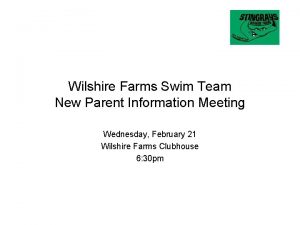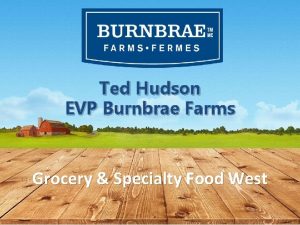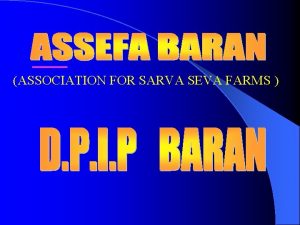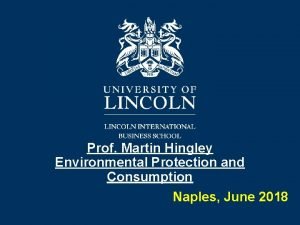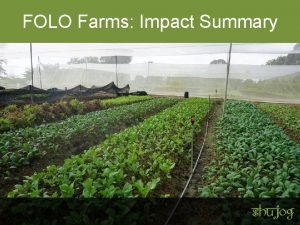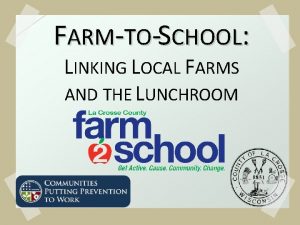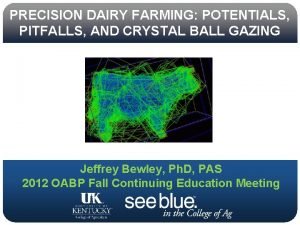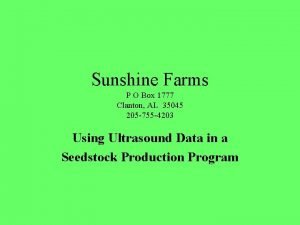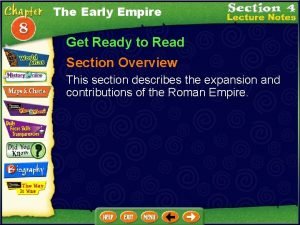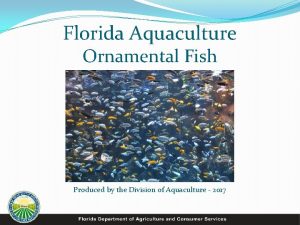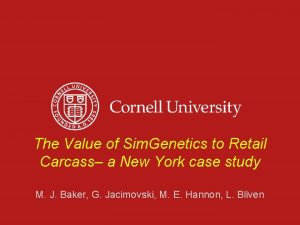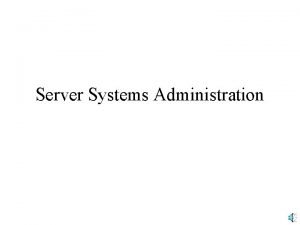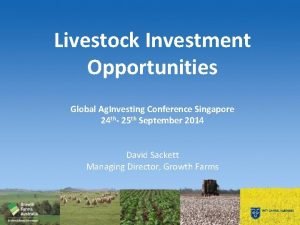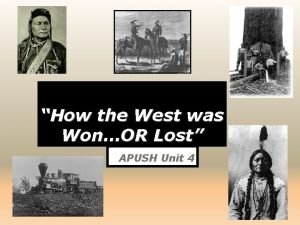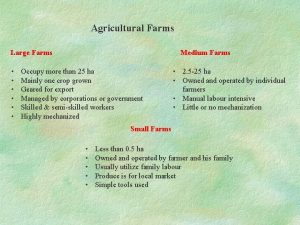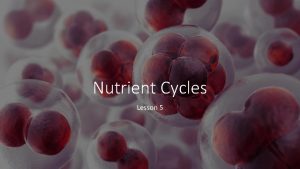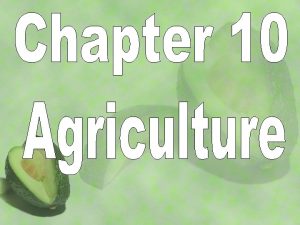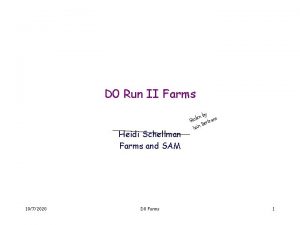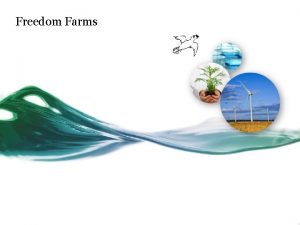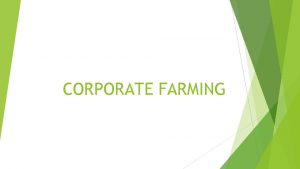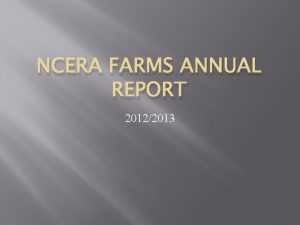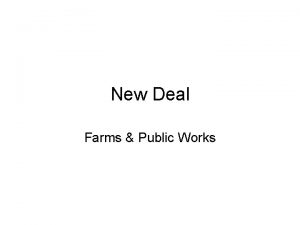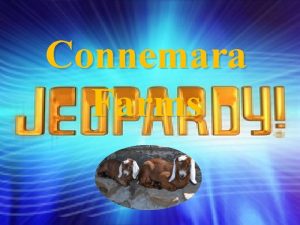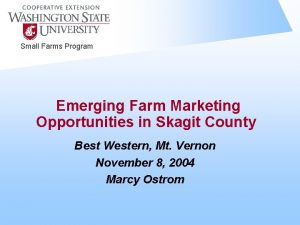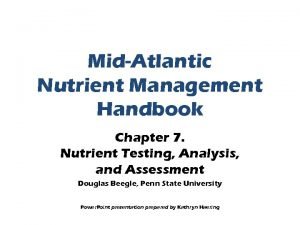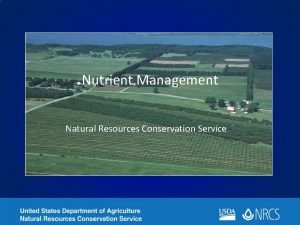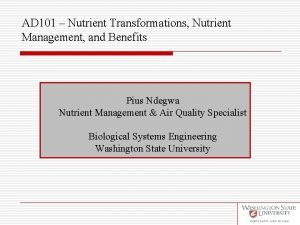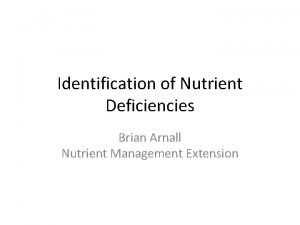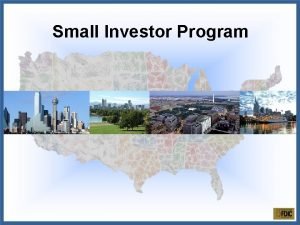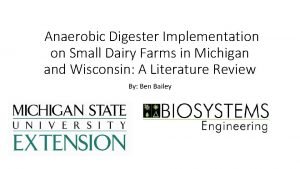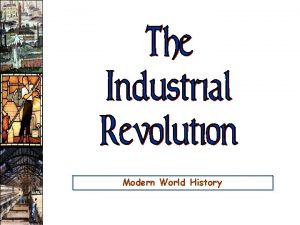Nutrient Management on Small Farms Nutrient Management Program


























- Slides: 26

Nutrient Management on Small Farms Nutrient Management Program

Small Farms Nutrient Management Program The Small Farms Nutrient Management Program was developed by Virginia Tech under a cooperative agreement with the Virginia Department of Conservation and Recreation to better serve the Virginia small-farming community. Virginia Tech’s Small Farms Nutrient Management Program team is dedicated to working with individuals to educate, improve water quality, develop nutrient management plans and provide technical support.

Purpose The purpose of the program is to help individuals develop strategies to best manage nutrients being applied to each crop grown.

What is a small farm? A small farm is considered any agriculture activity occurring on more than 10, 000 square feet and fewer than 400 acres or dairy operations with fewer than 200 animal units. Small farms may include dairy, beef, sheep, goat, horticulture and cut-flowers operations.

What is a nutrient management plan? Nutrient management plans are guides for applying organic or inorganic fertilizers to maximize yield while preventing the movement of nutrients into ground and surface waters. These plans are written to fit your farm and to meet your soil and yield goals.

Nutrient Management Plans in Virginia • 7, 000 nutrient management plans on Virginia farms • This covers more than 50% of the nearly 2 million acres in crop and hay production in the state • 75% of crop and hay acres in the Chesapeake Bay Watershed is covered by nutrient management plans • 12, 000 farms in Virginia with 140 or more acres, 60% of those farms are covered by nutrient management plans

Soil testing establishes a baseline for soil nutrients. Soil sample analyses are essential for accurate nutrient recommendations by crop and soil type and should be updated at least once every three years. As part of the program, there is no cost associated with soil testing.

What does a soil test show? • Excessive or deficient nutrients in the soil • Macronutrients (nitrogen, phosphorus and potassium) • Soil p. H • Micronutrients (calcium, magnesium, zinc, copper, iron and boron)

Benefits of a soil test • Excessive nutrient application and associated costs can be avoided. • Helps ensure that applied nutrients are available to the plants being grown. • Measures changes in soil nutrients over time.

Services Provided (All services are free to the farmer) • Soil sampling • Manure sampling • Pre-sidedress nitrate test • Equipment calibration • Manure and fertilizer recommendations • Lime recommendations • Nutrient management plans • Water quality agreement programs

Working with Shenandoah Valley Dairy Farmers

Working with Shenandoah Valley Dairy Farmers

Working with Shenandoah Valley Dairy Farmers

Working with Shenandoah Valley Dairy Farmers

Dairy Farms Come in All Shapes and Sizes

Water quality agreement program This horticultural and gardening water quality agreement program is designed to encourage and reward those who use the best soil nutrient management practices available to reduce nutrient losses to ground and surface waters. Producers meeting all requirements will receive yearly certification and the “Green and Clean” seal.

Water quality agreement program - Requirements • Fertilizer Application • Reporting • Auditing

Water quality agreement program – General Recommendations and Maintenance Practices • Maintain p. H - Liming • Avoid overwatering • Recycling of vegetation or composting is encouraged • Do not apply fertilizers to impervious surfaces • Educate other growers • Use the Green and Clean grower seal

Why nutrient management plans? • Provides a course of action for managing nutrients on the farm • Save money by avoiding costly off-farm fertilizer • Encourage split application of nutrients when the crops need it most • Improvement of water quality on and off the farm • Nutrient management plans that are followed and verified by the Virginia Department of Conservation and Recreation will assist the state in meeting its nutrient reduction requirements for the Chesapeake Bay TMDL

Chesapeake Bay TMDL • Crop System Corn Silage • Rockingham County 12, 137 acres Row Crops under NMP • Base Load under Nutrient Management • 150 lbs/ac Nitrogen • 140 lbs/ac Phosphorus • Non-NMP Base Load Corn Silage • 180 lbs/ac Nitrogen • 420 lbs/ac Phosphorus

Chesapeake Bay TMDL • Core Nutrient Management Implemented at Recommended Rates • Nitrogen reduced to 121. 5 lbs/ac on Corn Silage = or< 1 lb/bu yield converted to lbs/ton • Phosphorus reduced to 116. 2 lbs/ac on Corn Silage • No nutrient management related sediment reductions in the bay model – they are computed independent of each other

Chesapeake Bay TMDL • Enhanced Rate, Placement, and Timing Nutrient Management Implemented – Corn Silage • Nitrogen reduced to 99. 63 lbs/ac • Phosphorus reduced to 92. 96 lbs/ac • ADD Rye Cover Crop!!! • No Nutrients Applied • Nitrogen Reduced to 54. 8 lbs/ac • No Phosphorus Reduction • Add Conservation Tillage!!! • No Nitrogen Reduction • Phosphorus reduced to 58. 6 lbs/ac

Chesapeake Bay TMDL • Nutrient Reductions • Previous versions of the bay model for Nutrient Management credit reduced Non-NM load of 180 lbs/ac for all row crops to 169 lbs/ac. Cover crops and conservation tillage could not be applied to the same acre. • Big difference with the most recent model. • Acres Count ONLY if implemented, verified, and at proper rates, timing, etc.

Chesapeake Bay TMDL • Non – Nutrient Management Reductions • Corn Silage • Nitrogen base load 180 lbs/ ac • Phosphorus 420 lbs/ac • ADD cover crop • Nitrogen reduced to 117 lb/ac • No phosphorus reduction • ADD Conservation tillage • Phosphorus reduced to 273 lbs/ac • Still significantly higher than load for farm under nutrient management plan

Virginia NMP Verification July 1, 2015 through June 30, 2017 Year Farms Surveyed Acres Verified %Verification 7/1/15 – 6/30/16 217 72, 000 50, 400 70% 7/1/16 – 6/30/17 302 109, 623 90, 540 82. 6% 7/1/15 – 6/30/17 519 181, 623 140, 940 77. 6%

Small Farm Nutrient Management Team Tad Williams Dairy and Small Farms Nutrient Management Specialist Cell: 540 -290 -3602 taw 1776@vt. edu Williams provides technical assistance in developing nutrient management practices with a focus on dairies and beef operations without permits. The goal is to improve use of manure to protect water quality in Virginia. Tammy Holler Horticulture and Small Ruminant Nutrient Management Specialist Cell: 804 -229 -2730 tammyh 3@vt. edu Holler provides professional nutrient management guidance and assistance to small agronomic and livestock operations to improve water quality. The focus is on providing strategic ways of reducing nutrients entering ground and surface waters.
 Transport media for salmonella
Transport media for salmonella Integrated nutrient management for sustainable agriculture
Integrated nutrient management for sustainable agriculture Wilshire farms swim team
Wilshire farms swim team Ted hudson burnbrae farms
Ted hudson burnbrae farms Peterson farms loretto ky
Peterson farms loretto ky Seva farms
Seva farms Kiwiw farms
Kiwiw farms Redmere farms
Redmere farms Folo farms
Folo farms Jolivette family farms
Jolivette family farms Gorton v. doty
Gorton v. doty Pc farms
Pc farms Mastiline
Mastiline Amli at danada farms
Amli at danada farms Sunshine farms
Sunshine farms Floral shops bookstores and farms are examples of
Floral shops bookstores and farms are examples of Pros and cons of power
Pros and cons of power Read ready
Read ready Karsten farms
Karsten farms Imagination farms
Imagination farms Florida cichlid farms
Florida cichlid farms Wilson beef farms canaseraga ny
Wilson beef farms canaseraga ny Small servers
Small servers Seeland farms
Seeland farms Global ag investing
Global ag investing Boll weevil apush
Boll weevil apush Ahti farms
Ahti farms


